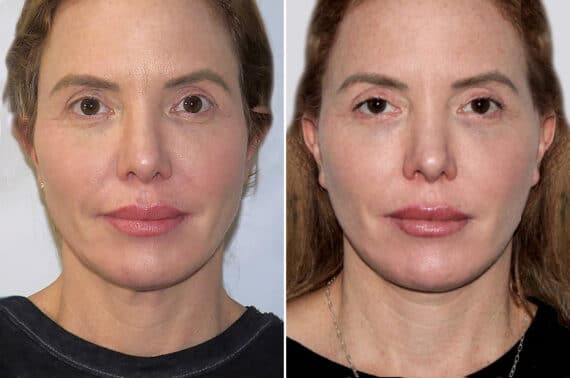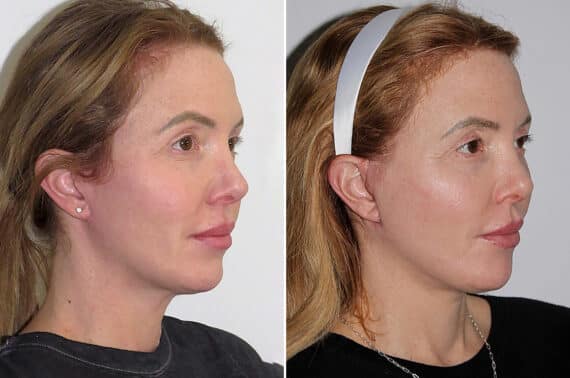
Ever looked in the mirror and wondered if there was a way to turn back time—without it looking like you had something done? Facelift procedures have come a long way, and today, two options stand out: the mini facelift and the deep plane facelift.
But which one is right for you? Whether you’re just starting to notice sagging skin or are looking for a more transformative result, understanding the difference between these two popular techniques is key to choosing the best path forward. Let’s dive into the details.
Key Difference Between a Mini Facelift and a Deep Plane Facelift
The main distinction between a mini facelift and a deep plane facelift lies in the depth of tissue repositioning and the scope of enhancement. A mini facelift targets early signs of aging around the jawline and lower face using smaller incisions, offering quicker recovery and subtler results. In contrast, a deep plane facelift repositions deeper facial layers across the cheeks, midface, and neck for more dramatic, long-lasting rejuvenation, though it typically requires a longer recovery period.
Techniques Involved During Surgery
Both mini and deep-plane facelifts aim to restore youthful contours, but they achieve this through very different surgical methods. Understanding the techniques used in each can give you a clearer picture of what to expect in terms of results, complexity, and recovery. Each procedure has unique advantages depending on how much correction is needed and how long-lasting the results should be.
The Deep Plane Facelift Procedure
The deep plane facelift surgery goes beneath the superficial musculoaponeurotic system (SMAS), releasing key ligaments and repositioning deeper facial tissues. This method allows for significant lifting of the midface and neck while minimizing tension on the skin itself. The dissection occurs in a deeper anatomical plane, which offers longer-lasting, more natural results. Compared to a mini facelift, it’s more technically demanding and involves more extensive internal adjustment, contributing to a longer recovery but delivering more dramatic facial rejuvenation.
The Mini Facelift Procedure
The mini facelift is a less invasive surgical technique that involves smaller incisions, typically placed around the ears. This mini lift tightens the superficial muscular layer (SMAS) without delving into deeper tissue, making it quicker and less complex than a deep plane facelift or even a traditional facelift. While it primarily addresses sagging in the lower face and jawline, it doesn’t provide the same degree of lift or longevity. The reduced invasiveness results in shorter surgery time, faster healing, and fewer risks—but also more modest aesthetic improvement.
Ideal Candidates for Each Procedure
Not all facelift techniques are suitable for every patient. Age, skin laxity, facial structure, and overall health all influence which procedure will deliver the best outcome. Identifying the ideal candidate for each facelift type helps set realistic expectations and ensures that the chosen method aligns with a patient’s aesthetic goals and lifestyle needs.
Deep Plane Facelift Candidates
Deep plane facelift candidates typically exhibit moderate to advanced signs of facial aging, including sagging cheeks, deep nasolabial folds, and loose skin in the neck. These individuals often seek more comprehensive and longer-lasting rejuvenation. Ideal patients are in good overall health, are non-smokers, and have realistic expectations about results and recovery. Compared to mini facelift candidates, they’re usually older and require more structural lifting rather than surface-level adjustments, making the deep plane technique a more suitable and effective choice.
Mini Facelift Candidates
Mini facelift candidates are generally younger individuals or those with early to moderate signs of aging, such as mild jowling or skin laxity in the lower face. They’re looking for subtle facial rejuvenation procedure without undergoing a major plastic surgery or long recovery. These patients often prefer less invasive options with quicker downtime. Compared to deep plane facelift candidates, they need less correction and benefit more from localized improvements, making the mini facelift an ideal option for maintaining a refreshed appearance with minimal disruption.
Recovery Time and Aftercare
Recovery experiences vary significantly between a deep plane facelift and a mini facelift, largely due to the invasiveness of each technique. Understanding what to expect after surgery helps patients plan accordingly and follow post-operative instructions that support optimal healing. From downtime to follow-up care, each approach has its own timeline and aftercare requirements that can influence a patient’s decision.
Deep Plane Facelift Recovery
Recovery from a deep plane facelift typically takes around two to three weeks, with swelling and bruising most noticeable during the first 10 days. Patients are usually advised to take at least two weeks off from work or social events. Because the surgery involves deeper tissue layers, aftercare includes diligent monitoring, limited physical activity, and follow-up visits to ensure proper healing. Though recovery is longer than a mini facelift, the results justify the downtime with more significant and enduring facial rejuvenation.
Mini Facelift Recovery
Recovery from a mini facelift is generally quicker and more comfortable than that of a deep plane facelift. Most patients return to normal activities within 7 to 10 days, with only mild swelling and bruising. The limited tissue disruption reduces the need for extensive aftercare, though proper rest and following post-op instructions are still essential. Compared to the deeper dissection required in a deep plane facelift, this procedure offers a smoother recovery process while still delivering visible, if more modest, aesthetic improvement.
Risks and Potential Complications
Every surgical procedure comes with some level of risk, and facelifts are no exception. While both deep plane and mini facelifts are considered safe when performed by a qualified surgeon, they differ in terms of complexity, invasiveness, and potential complications. Understanding these risks is key to making an informed decision and feeling confident in your surgical journey.
Deep Plane Facelift Risks
Because of its complexity and the depth of tissue manipulation, a deep plane facelift carries a higher risk profile than less invasive procedures. Potential complications include hematoma, nerve injury, infection, and prolonged swelling or bruising. Temporary numbness is also common. Although rare, facial nerve damage is a more serious concern. The extensive nature of the surgery requires a skilled surgeon to minimize these risks. Compared to a mini facelift, the deep plane approach demands greater surgical expertise and postoperative care.
Mini Facelift Risks
While a mini facelift is less invasive, it still carries some risks, though generally fewer than those associated with deeper procedures. Common complications may include bruising, swelling, infection, or minor scarring around the incision sites. Temporary numbness or tightness can occur but typically resolves within a few weeks. Because the mini facelift involves less dissection, the risk of nerve damage is lower compared to the deep plane facelift. Overall, it’s considered a safer option for patients with mild aging concerns.
Impact on Your Face’s Skin and Longevity
One of the most important factors when choosing between facelift techniques is how the results will look over time. Both deep plane and mini facelifts aim to restore youthful contours, but they differ in the degree of skin tightening, volume repositioning, and durability of results. This section explores how each procedure affects facial appearance long-term and what patients can realistically expect in terms of skin quality and aging progression.
Deep Plane Facelift Results
Deep plane facelifts deliver some of the most natural and long-lasting results in facial rejuvenation. Because the technique repositions deeper facial structures, it restores youthful volume and contours without creating a tight or overstretched appearance. Patients often enjoy results that last 10 to 15 years, with a smoother transition as the face continues to age. Compared to mini facelifts, the deep plane approach provides more comprehensive and durable enhancements across the cheeks, jawline, and neck.*
Mini Facelift Results
Mini facelift results are typically more subtle and short-term compared to those from a deep plane facelift. By focusing on tightening superficial tissues, the mini facelift smooths out early signs of aging, particularly along the jawline. While it can provide a refreshed and more youthful appearance, the effects tend to last around 5 to 7 years. The skin may continue to loosen with age, and touch-up procedures might be needed sooner. However, the outcome is still impactful for the right candidate.*
How To Choose the Best Type of Facelift for You
No matter which facelift approach you’re considering, selecting a highly experienced surgeon makes all the difference in achieving safe, natural-looking results. The complexity of facial anatomy, especially in deep plane procedures, demands precision, advanced technique, and an artistic eye to preserve and enhance your unique features.
Dr. Homer Hojjat is a double-board certified facial plastic surgeon and a member of the CSFPS, focusing exclusively on facial and neck cosmetic procedures. With a strong academic background, including published research on medical treatment efficiency and public perception of cosmetic surgery, Dr. Hojjat offers the perfect combination of technical skill and modern aesthetic vision. Call us today at 949-996-3274 or visit our contact page to schedule your consultation.





